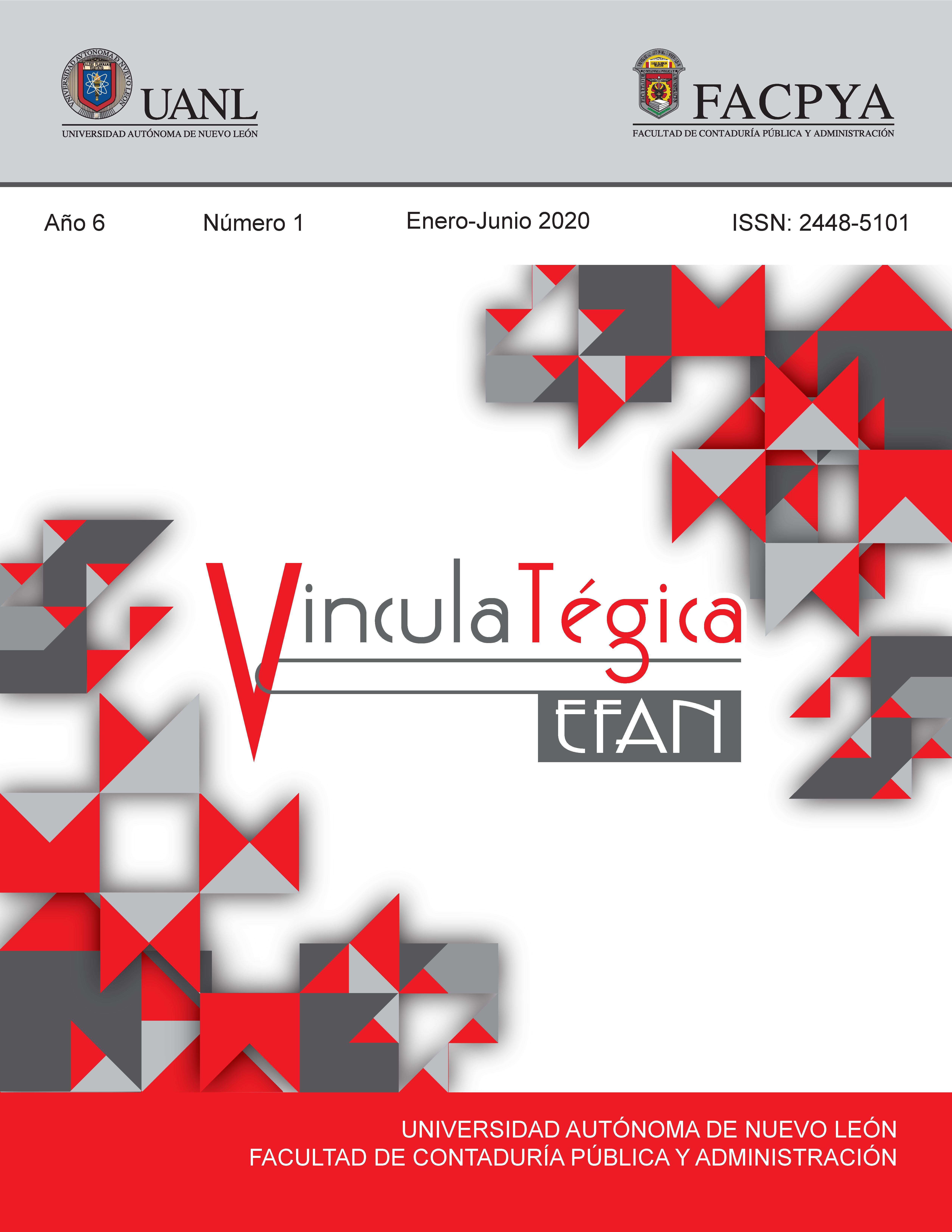Factores determinantes del capital humano en el sector público de Tamaulipas
DOI:
https://doi.org/10.29105/vtga6.1-633Palabras clave:
Capital humano, sector público, competencias, colaboraciónResumen
El objetivo de la presente investigación consiste en analizar
los factores determinantes que caracterizan el capital
humano adscrito a instituciones públicas del estado de
Tamaulipas. El estudio se realiza bajo un enfoque
cuantitativo, de alcance descriptivo, de corte transversal y
diseño no experimental. La muestra de participación estuvo
conformada por 125 encuestados. Como técnicas de análisis
de datos se recurre al análisis factorial exploratorio y
estadística descriptiva, específicamente, análisis de
frecuencias. Los resultados obtenidos manifiestan que los
factores determinantes del capital humano son las
competencias y colaboración, destacando de acuerdo con la
percepción de los participantes, que la mayoría del personal
sí posee estos atributos necesarios para la realización de sus
actividades. Los hallazgos observados aportan información
relevante para los tomadores de decisión respecto a las
implicaciones y áreas de mejora para una adecuada gestión
del personal que integra su organización.
Descargas
Citas
Aminu, M. I., & Mahmood, R. (2015). Mediating Role of Dynamic Capabilities on the Relationship between Intellectual Capital and Performance: A Hierarchical Component Model Perspective in PLS-SEM Path Modeling. Research Journal of Business Management, 9(3), 1–14. DOI: https://doi.org/10.3923/rjbm.2015.443.456
Bontis, N. (1998). Intellectual capital: an exploratory study that develops measures and models. Management Decision, 36(2), 63–76. DOI: https://doi.org/10.1108/00251749810204142
Bontis, N., Chua, W., & Richardson, S. (2000). Intellectual capital and business performance in Malaysian industries. ,. Journal of intellectual capital (Vol. 1). DOI: https://doi.org/10.1108/14691930010324188
Bontis, N., Crossan, M. and J. Hulland. (2002). Managing an Organizational Learning System by Aligning Stocks and Flows. Journal of Management Studies, 39(4), 437-469. DOI: https://doi.org/10.1111/1467-6486.t01-1-00299
Brooking, A. (1997). El capital intelectual: el principal activo de las empresas del tercer milenio. Barcelona: Editorial Paidós.
Cardona, M., Montes, I., Vásquez, J., Villegas, M., y Brito, T. (2007). Capital humano: Una mirada desde la educación y la experiencia laboral. Cuadernos de investigación, 56, 1-40.
Crema, M. y Verbano, C. (2014). Managing Intellectual Capital in Italian Manufacturing SMEs. Creativity and Innovation Management, 25(3), 408-421. DOI: https://doi.org/10.1111/caim.12074
Cummings, B. (2003). Transferring R&D knowledge: the key factors affecting knowledge transfer success. Journal of Engineering and Technology Management. 20, 39-68. DOI: https://doi.org/10.1016/S0923-4748(03)00004-3
Dhake, G. (1989). La comunicación humana. México D.F.: Mc Graw-Hill.
Díaz, C. (2013). Nueva Gestión Pública y Gobernanza: Desafíos en su implementación. International Journal of Good Conscience, 8(1), 177-194.
Euroforum (1998). Medición del Capital Intelectual. Modelo Intelect, Euroforum, Madrid. Recuperado de http://gestiondelconocimiento.com/modelo_modelo_intelec.htm.
García, M. y Leal, M. (2008). Evolución histórica del factor humano en las organizaciones: de recurso humano a capital intelectual. Omnia, 14(3), 144-159.
González, J. J. y Rodríguez, M. T. (2010). Modelos de capital intelectual y sus indicadores en la universidad pública. Cuadernos de Administración, 43, 113-128. DOI: https://doi.org/10.25100/cdea.v26i43.428
Guerrero, S., González, S., Matos, A. y Picón, E. (2015). Desarrollo del capital humano y su impacto en el desempeño de una institución microfinanciera no regulada del Perú. Apuntes Universitarios. Revista de Investigación, V (1), 51-68. DOI: https://doi.org/10.17162/81
Hair, J., Anderson, R., Tatham, R. y Black, W. (2008). Análisis multivariante. México, Prentice Hall.
Hernández, R., Fernández, C., Baptista, P. (2010). Metodología de la Investigación. México D.F., Editorial McGraw Hill.
Inkinen, H. (2015). Review of empirical research on intellectual capital and firm performance. Journal of Intellectual Capital, 16(3), 518–565. DOI: https://doi.org/10.1108/JIC-01-2015-0002
Instituto Mexicano para la Competitividad (2014). Productividad y Capital Humano. Recuperado de https://imco.org.mx/capital_humano/productividad-y-capital-humano/
Luthans, F. y Youssef, C. M. (2004). Human, social and now positive psychological capital management: Investing in people for competitive advantage. Organizational Dynamics, 33(2), 143-160 DOI: https://doi.org/10.1016/j.orgdyn.2004.01.003
Méndez, I., Namihira, D. Moreno, L. y Sosa, C. (2011). El protocolo de Investigación. Lineamientos para su elaboración y análisis. México: Trillas.
Münch, L. y Ángeles, E. (2007). Métodos y técnicas de investigación. México: Trillas.
Rong, D., Shizhong, A. & Yuqing, R. (2007). Relationship between knowledge sharing and performance: A survey in Xi'an, China. Expert Systems With Applications, 32(1), 38-46. DOI: https://doi.org/10.1016/j.eswa.2005.11.001
Ruggeri, G. y Yu (2000). On the dimensions of human capital: an analytical framework. Atlantic Canada Economics Association Papers, 29(1), 189-102.
Sánchez, A. J., Melián, A., & Hormiga, E. (2007). El concepto de capital intelectual y sus dimensiones. Investigaciones Europeas de Dirección y Economía de la Empresa, 13, 97–111.
Sarur, M. (2013). La importancia del capital intelectual en las Organizaciones. Ciencia Administrativa. 1(2013), 39 – 45. 838
Suraj, O., & Bontis, N. (2012). Managing intellectual capital in Nigerian telecommunications companies. Journal of Intellectual Capital, 13(2), 262–282. DOI: https://doi.org/10.1108/14691931211225724
Sveiby, K. (2000). La nueva riqueza de las empresas. Barcelona: Ediciones Gestión.
Vasconcelo, R. (2017). La relación del capital intelectual y el desempeño organizacional en el sector empresarial de Tamaulipas. Tesis de grado. Universidad Autónoma de Tamaulipas.
Viedma (2001) ICBS Intellectual Capital Benchmarking System. Journal of Intellectual Capital. 2(2), 148- 164. DOI: https://doi.org/10.1108/14691930110385937
Descargas
Publicado
Cómo citar
Número
Sección
Licencia

Esta obra está bajo una licencia internacional Creative Commons Atribución 4.0.
Los autores que publiquen en la revista VinculaTégica EFAN aceptan el siguiente aviso de derechos de autor:
a). Los autores conservan los derechos de autor y ceden a la revista el derecho de la primera publicación de la obra bajo una licencia de atribución de Creative Commons. Esta licencia permite a otros compartir la obra siempre que se reconozca la autoría original y la publicación inicial en esta revista.
b). Los autores pueden establecer acuerdos contractuales adicionales de manera independiente para la distribución no exclusiva de la versión publicada en la revista (por ejemplo, publicarla en un repositorio o incluirla en un libro), siempre que se reconozca la publicación inicial en esta revista.
c). Se permite a los autores autoarchivar su trabajo en repositorios institucionales o en su propio sitio web antes y durante el proceso de envío, ya que esto puede fomentar intercambios productivos y aumentar la citación temprana y general del trabajo publicado.







